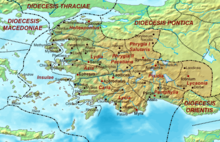Satala in Lydia
Appearance

Satala (Ancient Greek: Σάταλα) or Satala in Lydia was a Roman era city[1][2] and Bishopric[3] in ancient Lydia.
Location
[edit]Its site is located near Adala in Asiatic Turkey.[4][5]
Pagan religion
[edit]The city worshiped the typical mother and son pantheon found throughout Anatolia, and although a temple was built it did not mint coint as the town was only a village. It was part of a decapolis called the Katakekaumene, and May have been its religious center.
Bishopric
[edit]The city was also a see in the province of Lydia, and remains a vacant and titular see to this day.[6] It is in the province of Sardis.
Known Bishops
- Andrew[7] (Council of Chalcedon)
- Elpidius of Satala banished after the Council of Constantinople[8][9]
- Giuliano signed in 458 the letter of the bishops of Lydia to ' Emperor Leo I after the death of Proterius of Alexandria.
- Michael attended the Second Council of Nicaea (787) .
- Philip took part in the Council of Constantinople (879)
Today Satala Lidia survives as titular bishop of the Roman Catholic Church but the seat is vacant since 22 October 1819 .
- Catholic Titular Bishop Nikodem Puzyna September 26, 1814 October 22, 1819.[10][11][12]
See also
[edit]References
[edit]- ^ W. M. Ramsay, The Historical Geography of Asia Minor.(Cambridge University Press, 2010) p131.
- ^ Joseph Bingham, The Antiquities of the Christian Church, 2 Volumes (1848)p400.
- ^ Satala at Catholic heirachy.org.
- ^ Richard Talbert, ed. (2000). Barrington Atlas of the Greek and Roman World. Princeton University Press. p. 56, and directory notes accompanying. ISBN 978-0-691-03169-9.
- ^ Lund University. Digital Atlas of the Roman Empire.
- ^ "Satala in Lydia (Titular See) [Catholic-Hierarchy]".
- ^ Richard Price, Michael Gaddis, The Acts of the Council of Chalcedon, Volume 1 (Liverpool University Press, 2005) p91.
- ^ Philostorgius, in Photius, Epitome of the Ecclesiastical History of Philostorgius, book 5, chapter 1.
- ^ Socrates of Constantinople, Church History, book 2, chapter 42.
- ^ Beschreibung auf catholic-hierarchy.org (englisch)
- ^ "Apostolische Nachfolge – Titularsitze". Archived from the original on 2019-01-19. Retrieved 2016-10-07.
- ^ Eintrag auf gcatholic.org
